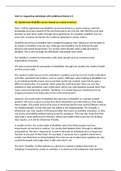Unit 12: Supporting Individuals with Additional Needs 2/2
P2: Explain how disability can be viewed as a social construct.
Now, I will be explaining how disability can be perceived as a social construct and how
knowledge and many aspects of the world around us are not real, and that they only exist
because we give them reality through social agreement. For example, disability may not
even exist, however we decide who is able by agreeing to certain criteria.
Disability and views on disability have changed throughout time. Behaviour was thought to
be based on disability centuries ago, although now disability can be defined through
physical and mental impairments. It is society which decides what is able and what is
disabled. This is seen through the definitions that people have made.
Our identity is created by interactions with other people and our reactions to the
expectations of society.
We have constructed the perception of disabilities through two models; the medical model
and the social model.
The medical model focuses on the individual’s condition and tries to treat it with medication
and other specialist interventions, such as surgery. Although, when looking at disabilities not
as an individual/medical issue, but as one that society has created, many tend to gain a
different perspective. For example, when using the medical model, there are very few
solutions to help wheelchair users climb stairs, which may unfortunately exclude them from
many crucial and leisurely activities. Therefore, it is society that has created barriers by
stopping someone from being able to live in the environment.
However, the social model of disability sees the issue of disability as a socially created
problem. We have created a society that limits wheelchair users like Rebecca, that makes
them unable. This model aims to find ways of removing barriers that restrict lifestyle choices
for disabled people, so that they gain the ability to live independently. For example, a
wheelchair user may require a lift being installed that meets accessibility standards, so they
can access any building without having to ask for assistance. This may also mean that they
may need a ramp added to the entrance, which may enable them to go into any building
they require, as it will be wheelchair friendly.
In relation to this, the social model of disability states that while people may have
impairments of one kind or another, it is society that disables them, through its attitudes
and practices. The term ‘impairment’ is used to describe an individual who no longer has
function in one part of their body. For example, if someone has a cognitive impairment,
society may label them as being disabled. The tests we use to determine cognition are also
created by people who judge what is able and what is not.
The term ‘disability’ is often defined as a physical or mental condition that limits an
individual’s movements, senses or activities. It is society and its institutions who have the





